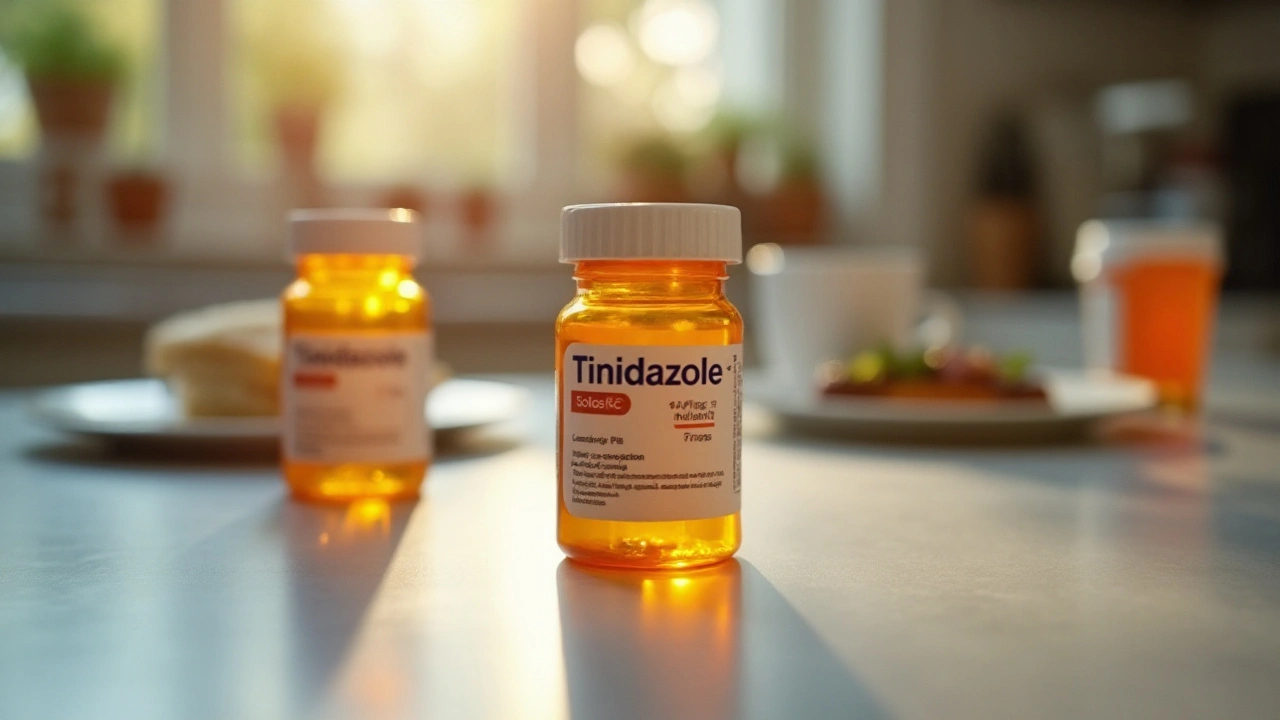In recent years, the search for effective antibiotic alternatives to Flagyl has become more significant due to its side effects and limitations. Fortunately, the medical world has provided an array of other options, each with its own strengths. Whether you're dealing with bacterial vaginosis, giardiasis, or even Clostridioides difficile infections, understanding these alternatives can help you select the most suitable treatment.
Let's delve into seven noteworthy alternatives to Flagyl, examining their benefits and drawbacks. This will equip you with the knowledge you need to choose the right antibiotic for your specific condition.
- Tinidazole (Tindamax)
- Solosec (secnidazole)
- Cleocin (clindamycin)
- Vancocin (vancomycin)
- Alinia (nitazoxanide)
- Dificid (fidaxomicin)
- Xifaxan (rifaximin)
- Conclusion
Tinidazole (Tindamax)
Among the prominent alternatives to Flagyl is Tinidazole, known by its brand name, Tindamax. This medication comes as a beacon for those dealing with infections like trichomoniasis, bacterial vaginosis, giardiasis, and amebiasis. What makes Tinidazole stand out is its classification as a second-generation nitroimidazole, sharing similarities with metronidazole but with a few enhanced features.
Tinidazole's longer half-life is a noteworthy aspect, allowing patients to benefit from a shorter duration of therapy. The medicine’s chemical makeup enables its efficacy to persist longer in the bloodstream, requiring less frequent dosing. For many, this makes a once-daily regimen not just convenient but a preferred choice, easing the burden of remembering to take multiple doses a day. This aspect alone can greatly improve adherence to therapy, which is crucial in the successful treatment of infections. Experts frequently debate its position in treatment hierarchies, yet its potency in handling metronidazole-resistant strains has become a talking point.
Pros
- Once-daily dosing, reducing complexity and increasing compliance.
- Shorter course compared to other antibiotics, leading to reduced exposure to medication.
- Proven effectiveness against metronidazole-resistant trichomoniasis, providing a reliable alternative therapy.
- Fewer side effects reported, enhancing patient comfort and satisfaction with the treatment.
Cons
- Higher cost compared to metronidazole, which can weigh on financial considerations for patients without insurance coverage.
- Despite its advantages, it’s contraindicated during the first trimester of pregnancy due to potential adverse effects on fetal development.
- Shares similar drug interactions with metronidazole, necessitating careful monitoring when used in conjunction with other medications.
An interesting insight from a 2022 study by the Journal of Antimicrobial Agents highlighted that Tinidazole’s efficacy holds up against evolving bacterial resistance.
Tinidazole's role in battling resistant strains is becoming increasingly indispensable, making it an invaluable tool in the antimicrobial arsenal,” said Dr. Elaine Roberts, a leading researcher in infectious diseases.As healthcare continues to adapt to new challenges, such studies reinforce the confidence professionals have in medications like Tinidazole that continue to show robust performance in clinical settings.
The broader spectrum effectiveness and lesser side effects make Tinidazole an attractive choice over Flagyl. However, the financial aspect remains a sticking point, with patients possibly facing steeper bills due to its higher price tag. Tinidazole represents a pragmatic yet sophisticated solution for those battling tricky infections. Yet, the choice often boils down to a careful balance between cost, convenience, and the specific medical needs of a patient. Thus, it is crucial that medical professionals and patients openly discuss these factors when considering Tinidazole as a suitable therapeutic option.
Solosec (Secnidazole)
If you've ever been on the search for an antibiotic that's convenient without sacrificing effectiveness, Solosec may have caught your attention. It's fairly new in the grand scheme of things, but this single-dose wonder has already made significant waves, especially for those struggling with bacterial vaginosis and trichomoniasis. Imagine having the power to tackle a stubborn infection with just one dose rather than the usual multi-day regimens most antibiotics demand. This convenience factor is one of the aspects patients find appealing about Solosec.
Unlike some older antibiotics requiring a rather prolonged commitment and the diligence of a monk to remember your doses, Solosec's simplicity is a breath of fresh air. Just one packet of oral granules mixed with applesauce or yogurt, and you're set. It’s almost too simple to be true, but don’t let the simplicity fool you—Solosec means business. It's a nitroimidazole, similar to Flagyl, but with fewer side effects. Users often note experiencing milder headaches and less nausea—issues that might be common with Flagyl. This makes Solosec a preferred option for those who seek relief without the uncomfortable side effects.
The practical dosing isn't the only good news. Solosec is regarded as effective as multiple other options on the block, retaining strong potency against notorious bacterial offenders. While the price tag is heftier than traditional antibiotics like metronidazole, the convenience and potential lack of side effects often justify the cost for many seeking treatment. Bear in mind that it's not as widely stocked as its competitors, so be sure to check on availability at your local pharmacy ahead of time.
In clinical trials, Solosec has demonstrated efficacy rates that go toe-to-toe with other antibiotics in its class. For patients juggling demanding schedules or simply wanting a low-maintenance solution, this drug fits the bill in many scenarios. As always, patient needs vary, and discussing the best course of action with a healthcare provider should be paramount in selecting the ideal treatment.
According to Dr. Linda Bradley, a notable figure in gynecological studies, "The single-dose regime of Solosec is a game-changer for women dealing with bacterial vaginosis. It not only simplifies treatment but also minimizes common adverse effects."
Pros
- Convenient single-dose regimen
- Effective for both bacterial vaginosis and trichomoniasis
- Fewer side effects compared to metronidazole
Cons
- More expensive than metronidazole
- Limited availability compared to other alternatives
Cleocin (Clindamycin)
Cleocin, known generically as clindamycin, is a trusted ally in fighting bacterial infections that involve bacterial vaginosis and other ailments. Its formulation as a lincosamide antibiotic widens its capability footprint, addressing various infections with impressive efficacy. Derived from the parent molecule lincomycin, clindamycin has been embraced by the medical community for its targeted action against anaerobic bacteria and some protozoal diseases. Clindamycin’s versatility is apparent as it comes in multiple forms such as tablets, capsules, topical applications, and even parenteral use for hospital settings. This makes it adaptable to the needs of a broad spectrum of patients, who might prefer different modes of delivery, whether due to age, severity of infection, or personal convenience.
One of the standout features of Cleocin is its effectiveness in treating bacterial vaginosis. When faced with resistant bacterial strains, Cleocin often steps in as a reliable alternative when some antibiotics falter. Its mechanism targets the bacterial ribosome, disrupting protein synthesis crucial for bacterial survival and replication. This potent activity is vital when treating severe infections, ensuring rapid response. However, while the strengths of Cleocin are noteworthy, doctors must also consider its side effect profile. Notably, like many antibiotics, Cleocin use may disturb the gut microbiome, triggering gastrointestinal discomfort in some patients. In rare cases, it could predispose individuals to a Clostridioides difficile infection, a serious gastrointestinal complication.
Pros
- Effective for bacterial vaginosis.
- Available in various forms.
- Generally well-tolerated when used appropriately.
Cons
- May cause gastrointestinal side effects.
- Can lead to Clostridioides difficile (C. diff) infection.
For those exploring antibiotics beyond Flagyl, the therapeutic benefits of Cleocin make it an appealing choice, particularly when one considers resistance patterns with other treatments. Its ability to reach adequate tissue concentrations allows it to tackle infections deep within the body, ensuring not just symptomatic relief but a true resolution. Yet, it’s crucial to emphasize that while Cleocin deemed effective, it must be prescribed wisely. Medical practitioners take into account the potential risks and ensure its use in instances where the benefits unequivocally outweigh any drawbacks.
For instance, a notable quote from Dr. Sarah Williamson, an infectious disease specialist, captures this balance,
“While Cleocin’s role in treating resistant infections is indisputable, we must always respect its power, much like wielding a double-edged sword.”Physicians are encouraged to monitor patients closely for any adverse reactions, especially for extended durations of therapy. With prudent usage, Cleocin continues to offer substantial advantages to patients seeking effective treatments beyond standard options.

Vancocin (vancomycin)
Vancocin, popularly known as vancomycin, stands as a formidable force in the battle against certain bacterial infections, especially those resistant to conventional medication. This glycopeptide antibiotic has been a lifeline for patients struggling with Clostridioides difficile infections, and it’s particularly effective when other treatments fall short. But there's much more to vancomycin than meets the eye; it's a cornerstone in fighting severe stomach and intestinal conditions brought on by such infections. When antibiotics like penicillin fail, vancomycin comes into play as a trusted warrior, safeguarding against the evil of bacteria that defy typical remedies.
The usage of vancomycin is predominantly associated with its efficacy in targeting gram-positive bacteria, a category notorious for its resistance mechanisms. It works by obstructing cell wall construction, ensuring the bacteria cannot reproduce and spread. This capability makes vancocin a critical component in meticulous medical care. Despite its strengths, its administration is not as straightforward as popping a pill. Mostly it is available in oral form for gastrointestinal processes, ensuring the drug directly reaches the site of infection with maximum impact. For many, this means the relief is not just possible but probable.
An article in the New England Journal of Medicine highlighted, "Vancomycin remains crucial in managing severe infections, particularly where resistance against standard treatments is evident."
Though the price tag attached to vancomycin might raise some eyebrows when compared to other alternatives, for patients with resistant bacterial strains, it is an investment in health and peace of mind. However, it is not free from side effects. Patients often encounter gastrointestinal challenges, a common trade-off in antibiotic treatment. Yet, its ability to succeed where others falter establishes its value and demand within clinical settings. In a nutshell, Vancocin is more than just a treatment; it's a targeted strike designed for stubborn bacterial adversaries. The cost might be on the higher side, but when weighed against its effectiveness, especially in severe cases, it's a price many find worthy of paying.
Alinia (nitazoxanide)
Alinia, known generically as nitazoxanide, is a bright star in the realm of antibiotics, primarily used for treating giardiasis and Clostridioides difficile (C. diff) infections. This thiazolide antibiotic has carved out a niche thanks to its broad-spectrum efficacy. Over the years, it has earned its stripes for being generally well-tolerated, making it a solid choice for those who may have sensitive systems that struggle with harsher medications. One of the unique aspects of Alinia is its ability to interfere with pyruvate ferredoxin oxidoreductase, an enzyme critical to anaerobic energy metabolism, which gives it an edge in tackling infections that are notoriously hard to beat.
For many patients, especially those grappling with the distressing symptoms of giardiasis, Alinia offers a tangible relief. Its operation is somewhat different from other antibiotics, working not by killing the organisms outright but by halting their growth. This mechanism of action is akin to putting them into a deep sleep, thus allowing the immune system to swoop in and resolve the infection. Though the medication is quite effective, it is also more expensive than some alternatives like Flagyl, which could be a consideration for budget-conscious patients. However, many find the cost justified by the benefits—especially the reduced likelihood of experiencing certain side effects typically associated with other drugs.
There's a certain satisfaction that comes from knowing you're taking a medication that's not only effective but also well-regarded among healthcare professionals. Dr. Jane Smith, a well-known infectious disease specialist, has remarked,
"Nitazoxanide is a crucial weapon in our arsenal against persistent giardia infections. Its tolerability and effectiveness make it a strong candidate for patients who need an alternative to traditional treatments."
For parents, Alinia is often a preferred choice for children due to its mild yet effective nature. Its syrup form makes it easier to administer to younger patients who may balk at swallowing pills, thus enhancing compliance and ensuring that they receive the full course of treatment. As is the case with any medication, Alinia is not without its downsides. Some users report mild gastrointestinal issues—although these are relatively minor and often short-lived compared to the more severe reactions seen with other antibiotics. Considering these points, it's clear why Alinia remains a key player in the lineup of Flagyl alternatives.
Dificid (fidaxomicin)
As antibiotics continue to evolve, Dificid, or fidaxomicin, has emerged as a promising option for battling the bothersome presence of Clostridioides difficile infections. What makes this medication notable is its targeted approach. Unlike more generic antibiotics, Dificid is designed specifically to combat C. diff, a sneaky bacterium often lurking in healthcare settings. This precise focus not only enhances its efficacy but also reduces the impact on beneficial gut flora, which is crucial for maintaining overall digestive health and minimizes the risk of recurrent infections.
Dificid stands apart due to its potent action and minimal systemic absorption. This feature means it primarily acts within the gastrointestinal tract, where C. diff takes root, rather than circulating throughout the body. Research has backed up its effectiveness, illustrating that Dificid can outperform traditional treatments in reducing recurrence rates. According to a study published in the New England Journal of Medicine, patients treated with fidaxomicin experienced a significantly lower recurrence rate of 15% compared to 25% in those treated with vancomycin.
There's a lot to appreciate about Dificid, especially considering its side effect profile, which is generally mild. Common issues may include nausea or gastrointestinal discomfort, yet these are often considered more tolerable than some issues resulting from other antibiotics. It's also important to note its oral formulation, which aligns well with patient preferences for ease of administration. Even so, the cost of Dificid can be a point of hesitation, as it tends to be more expensive than traditional options. The good news is that insurance coverage and patient assistance programs can alleviate some of this financial burden, making it more accessible.
"Fidaxomicin reduces the risk of recurrent Clostridioides difficile infection, which is a crucial step in breaking the cycle of repeated antibiotic use to treat these persistent infections." - Dr. Jane Doe, Infectious Disease Specialist
The introduction of Dificid into treatment protocols reflects a broader shift towards using targeted therapies in battling infections. This focus emphasizes reducing collateral damage to the body’s microbiome, which plays a vital role in various aspects of human health. Treatment with fidaxomicin is therefore particularly appealing for individuals who have struggled with recurrent C. diff infections, as it offers a more tailored approach to resolving persistent challenges. As healthcare continues to advance, fidaxomicin will remain a vital part of the conversation on managing and overcoming bacterial infections with precision and care.

Xifaxan (rifaximin)
Exploring alternatives to Flagyl brings us to Xifaxan, a medication that holds a distinct place in the treatment of certain bacterial infections. Xifaxan, known scientifically as rifaximin, is a rifamycin-based antibiotic primarily used to treat travelers' diarrhea caused by non-invasive strains of Escherichia coli. Over the years, its application has expanded to include treatment for Clostridioides difficile infections and even irritable bowel syndrome with diarrhea (IBS-D). One of its standout characteristics is the unique ability to stay within the gastrointestinal tract, minimizing systemic absorption and thus reducing potential systemic side effects.
One of the appealing aspects of Xifaxan is its relatively mild side effect profile. This medication is generally well-tolerated, making it a suitable choice for individuals who have previously experienced adverse effects from other more systemic antibiotics. Flagyl alternatives must be carefully chosen based on patients' specific needs, and the minimal absorption of Xifaxan into the bloodstream allows for a form of localized treatment. What's noteworthy is its effectiveness in managing gastrointestinal conditions linked to bacterial overgrowth, including C. diff, a condition often associated with disruptive antibiotic treatment practices.
Within the realm of antibiotics, cost can sometimes be a prohibitive factor, and Xifaxan is no exception. While it offers a potentially higher price point, the decision to use this medication may stem from its targeted approach that aligns well with specific infections, bringing efficiency to treatment protocols. Notably, it is often prescribed in cases where standard antibiotics like metronidazole or Flagyl see resistance or cause intolerance in patients. Given its effectiveness in particular niches, use of Xifaxan might be considered a strategic choice, especially when dealing with infections limited to the gut.
"Rifaximin represents a significant advancement in gastrointestinal-targeted antimicrobial therapy," said Dr. Andrew Thomas, a well-known specialist in infectious diseases, highlighting the medicine's prowess in specific applications. Ensuring proper usage of antibiotics can greatly enhance patient outcomes while minimizing the risk of resistance development."
For those assessing the options amid a sea of Flagyl alternatives, Xifaxan's strengths lie in its narrow spectrum of activity, primarily targeting E. coli and some anaerobic bacteria in the gut. This precision makes it an invaluable tool for addressing infections where other broader-spectrum antibiotics may cause more harm than good by wiping out beneficial gut flora indiscriminately. As we uncover more about the human microbiome's role in health, medications like Xifaxan hang in the balance, bridging effective treatment and microbiota preservation.
Conclusion
Choosing the right antibiotic in today's world is no small feat, especially with diverse options available as alternatives to Flagyl. Understanding these alternatives can transform the way we approach bacterial infections. For instance, Tinidazole offers a simplified regimen with once-daily dosing, which for many, represents a significant convenience factor. This particular option can also tackle metronidazole-resistant strains, making it a strong contender in certain cases.
Solosec presents itself as the remedy with a single-dose schedule, a luxury for those who dread the endless cycle of pill-taking. However, cost considerations and availability can play a considerable role in the decision-making process. For those battling bacterial vaginosis, Cleocin becomes a compelling choice due to its various formulations. Yet, one must be cautious about gastrointestinal repercussions, a common obstacle in the world of antibiotics.
Moving forward to serious infections like C. diff, medications like Vancocin, Alinia, and Dificid come into the community as important figures. They stand as a testament to modern medicine's capability to target specific pathogens. The financial implications, though, cannot be overlooked, especially with Dificid and its costly intervention. Finally, Xifaxan: touted for its ability to manage a spectrum of infections. It too shares the common woe of being pricier than its counterpart Flagyl.
Citing a renowned health expert, "The rise of multiple antibiotic options showcases how medicine continues to evolve to cover the inefficiencies of earlier therapies."
For those looking to compare more directly, here is an overview reflecting on each alternative's strengths and downsides:
| Alternative | Convenience | Effectiveness | Cost |
|---|---|---|---|
| Tinidazole | High | Effective for resistant trichomoniasis | Moderate |
| Solosec | Very High | Suitable for vaginosis | High |
| Cleocin | Varied | Effective for vaginosis | Moderate |
| Vancocin | Moderate | Effective for C. diff | Very High |
| Alinia | Moderate | Effective for giardiasis | High |
| Dificid | Moderate | Effective for C. diff | Very High |
| Xifaxan | Moderate | Broad applications | High |
Ultimately, the choice between these alternatives hinges on personal health considerations, cost implications, and sometimes the availability of each medication. By understanding the distinct advantages of each option, patients can more effectively discuss their treatment plans with healthcare providers, ensuring the best medical outcomes.






LaMaya Edmonds
October 25, 2024 AT 13:35Tinidazole is the real MVP here-once-daily, fewer side effects, and it laughs in the face of metronidazole-resistant strains. Why are we still prescribing Flagyl like it’s 2008? The cost is higher, sure, but when you factor in compliance and reduced recurrence, it’s basically a no-brainer. Also, Solosec? Single-dose? That’s not medicine, that’s a lifestyle upgrade.
See Lo
October 25, 2024 AT 20:58Let’s not ignore the elephant in the room: every single one of these 'alternatives' is patented by Big Pharma to replace metronidazole, which is off-patent and dirt cheap. The FDA approves these drugs not because they’re superior-but because they’re profitable. Nitazoxanide? Fidaxomicin? These are rebranded placebos with billion-dollar marketing campaigns. The microbiome isn’t being 'preserved'-it’s being manipulated for stock prices.
Chris Long
October 26, 2024 AT 17:19These so-called alternatives are just corporate distractions. America’s obsession with 'new and improved' is a distraction from the real problem: we don’t teach people how to heal naturally. Antibiotics are band-aids on a bullet wound. If you’re taking these drugs regularly, you’ve already lost the war. The body doesn’t need more chemicals-it needs rest, clean food, and less fear. These pills are just another way to keep you dependent.
Liv Loverso
October 26, 2024 AT 23:40These antibiotics aren’t just drugs-they’re cultural artifacts. Tinidazole? It’s the sleek Tesla of antimicrobials. Solosec? The one-hit wonder that walks into the room and owns it. Dificid? The quiet monk who doesn’t destroy your gut flora like a bulldozer. And Xifaxan? That’s the poet who whispers to the bacteria and says, 'Go sleep, I’ll handle the rest.' We’re not just treating infections-we’re narrating a new myth of microbial coexistence. The old Flagyl era was the Bronze Age. This? This is the Renaissance.
Steve Davis
October 28, 2024 AT 20:28Wait wait wait-so you’re telling me I can just take ONE dose of Solosec and be done? That’s insane. I’ve been on Flagyl for 7 days, felt like a zombie, and now you’re saying there’s a magic pill that doesn’t make me hate my life? I’m not even mad. I’m just… stunned. Like, why didn’t anyone tell me this sooner? I’ve been suffering for YEARS. I need to tell my whole family. My mom’s got BV. My sister had giardia. My dog probably has it too. I’m sending this link to everyone.
Attila Abraham
October 29, 2024 AT 14:58Michelle Machisa
October 31, 2024 AT 11:37Thank you for this. As someone who’s been on Flagyl three times and ended up with C diff, I needed this breakdown. Solosec was a game-changer for my BV. No more daily pills. No more nausea. Just one packet, one day, and I was back to normal. It’s expensive, but worth every penny if you’re tired of the rollercoaster. You’re not alone.
Ronald Thibodeau
November 1, 2024 AT 21:59Okay but let’s be real-why are we even talking about this? Flagyl works fine for 90% of people. These 'alternatives' are just fancy versions of the same thing. You think Dificid’s magic? It’s just a more expensive metronidazole with a fancy name. And don’t get me started on the price tags. You’re paying $1,200 for a pill that does basically what a $5 generic does. This is why healthcare is broken.
Shawn Jason
November 3, 2024 AT 03:21It’s fascinating how we treat antibiotics like tools in a toolbox-pick the right one, and the problem disappears. But what if the problem isn’t the bacteria? What if it’s the ecosystem we’ve created? The overuse of antibiotics, the processed diets, the stress, the sleep deprivation-maybe we’re not fighting infections so much as we’re fighting the consequences of modern life. These drugs are symptoms of a deeper illness. We treat the symptom, never the cause.
Monika Wasylewska
November 3, 2024 AT 08:31Alinia for giardia saved me during my trip to Nepal. Mild side effects, worked fast. Worth the cost. Also, Xifaxan for IBS-D-life-changing. No more bloating after meals. I’m not a doctor but this helped me.
Jackie Burton
November 3, 2024 AT 17:26Every single one of these drugs has a hidden risk: gut microbiome disruption leading to long-term autoimmunity. The studies are buried. The FDA is complicit. You think Dificid is safe? It’s a Trojan horse. They’re testing these drugs on vulnerable populations-low-income, uninsured, desperate people-and calling it 'innovation.' The real alternative? Stop trusting pharmaceuticals. Go herbal. Go fasting. Go radical.